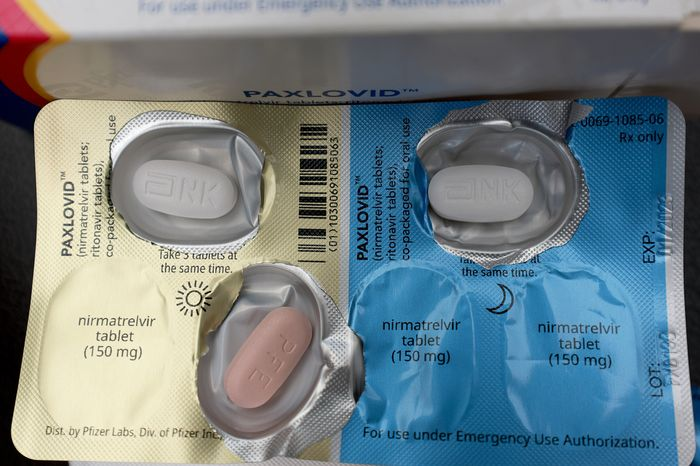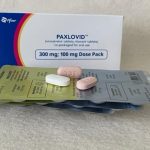List Of Drugs That Interact With Paxlovid (Top 30)

Paxlovid (generic name: molnupiravir) is an antiviral medication developed to treat COVID-19 infections. It belongs to a class of drugs known as nucleoside analogs. When a person is infected with a virus, the virus replicates inside their cells, using the host’s cellular machinery to produce more viral particles. Paxlovid works by inhibiting the replication of the SARS-CoV-2 virus, which causes COVID-19.
The active ingredient in Paxlovid, molnupiravir, is converted into its active form, a nucleoside analog, inside the body. This active form closely resembles one of the building blocks of the virus’s genetic material, RNA. When the virus tries to replicate, it mistakenly incorporates the active form of molnupiravir into its RNA chain instead of the correct building block.
This incorporation of molnupiravir disrupts the normal functioning of the viral RNA chain, preventing it from being properly copied and synthesized. As a result, the virus cannot replicate effectively, leading to a reduction in the viral load in the body. By inhibiting viral replication, Paxlovid helps to control the spread of the virus and reduce the severity and duration of COVID-19 symptoms.
It is important to note that Paxlovid is intended for use in individuals who are at high risk of developing severe illness from COVID-19, such as those who are elderly or have certain underlying medical conditions. However, as with any medication, it is essential to be aware of potential drug interactions to ensure the safe and effective use of Paxlovid. Drug interactions can occur when two or more substances interact in a way that alters the effectiveness or safety of one or both drugs.
In this article, we will explore the top 30 drugs that interact with Paxlovid, shedding light on the potential risks and necessary precautions to take. Understanding potential drug interactions is also crucial for the safe and effective use of Paxlovid. Examples of drugs that can interact with Paxlovid include:
1. Antacids: Antacids containing aluminum or magnesium can reduce the absorption of Paxlovid, thus diminishing its effectiveness. It is advisable to take Paxlovid two hours before or four hours after an antacid dose. Examples: Aluminum hydroxide, magnesium hydroxide
2. Proton Pump Inhibitors (PPIs): PPIs, such as omeprazole and esomeprazole, may decrease the absorption of Paxlovid. Administering Paxlovid two hours before or six hours after PPIs can help mitigate the interaction.
3. H2 Receptor Antagonists: H2 receptor antagonists, like ranitidine and famotidine, may reduce the absorption of Paxlovid. Taking Paxlovid two hours before or six hours after H2 receptor antagonists is recommended.
4. Calcium Channel Blockers: Paxlovid can increase the concentration of certain calcium channel blockers, leading to an increased risk of adverse effects. Close monitoring is advised when combining these medications.
5. Oral Contraceptives: Paxlovid may decrease the effectiveness of oral contraceptives. Alternative or additional contraceptive methods should be considered during Paxlovid treatment and for at least two weeks after stopping the medication.
6. Immunomodulators: Drugs that modulate the immune system, such as tacrolimus and cyclosporine, may have their effects altered by Paxlovid. Careful monitoring of immunosuppressive therapy is crucial during concurrent use.
7. Anticoagulants: Paxlovid can increase the anticoagulant effects of medications like warfarin or rivaroxaban, potentially leading to an increased risk of bleeding. Frequent monitoring of coagulation parameters is necessary.
8. Antidepressants: Some antidepressants, including selective serotonin reuptake inhibitors (SSRIs) and serotonin-norepinephrine reuptake inhibitors (SNRIs), may have their concentrations altered by Paxlovid. Dose adjustments and close monitoring are advisable.
9. Statins: Paxlovid can increase the concentration of certain statins, potentially leading to an increased risk of statin-related adverse effects. Adjustments in statin dose may be necessary.
10. Antiarrhythmics: Paxlovid may increase the concentration of antiarrhythmic medications like amiodarone, potentially leading to an increased risk of adverse effects. Close monitoring of cardiac function is essential.
11. Antidiabetic Medications: Paxlovid can affect blood sugar levels and may require adjustments to antidiabetic medications like insulin or oral hypoglycemic agents. Frequent monitoring of blood glucose is necessary during Paxlovid treatment.
12. Antihypertensives: Paxlovid can increase the concentration of certain antihypertensive medications, potentially leading to an increased risk of hypotension. Blood pressure should be closely monitored, and dosage adjustments may be required.
13. Nonsteroidal Anti-inflammatory Drugs (NSAIDs): Concurrent use of NSAIDs with Paxlovid may increase the risk of renal toxicity. Caution should be exercised when combining these medications, particularly in individuals with pre-existing renal impairment.
14. Anticonvulsants: Paxlovid can affect the concentrations of anticonvulsant medications like phenytoin and carbamazepine, potentially necessitating dose adjustments. Regular monitoring of anticonvulsant levels is crucial.
15. Antifungal Medications: Certain antifungal drugs, such as ketoconazole and itraconazole, can increase the concentration of Paxlovid. Dose adjustments and careful monitoring for adverse effects are advised.
16. Antiemetics: Paxlovid may affect the concentration of antiemetic medications like ondansetron or metoclopramide. Close monitoring of antiemetic effectiveness and potential adverse effects is necessary.
17. Antibiotics: Some antibiotics, including erythromycin and clarithromycin, can increase the concentration of Paxlovid. Dose adjustments and monitoring for adverse effects are recommended.
18. Antihistamines: Paxlovid may increase the concentration of antihistamines like cetirizine or loratadine, potentially leading to an increased risk of sedation. Caution should be exercised when combining these medications.
19. Antipsychotics: Paxlovid can affect the concentrations of antipsychotic medications like quetiapine or risperidone, potentially necessitating dose adjustments. Close monitoring for effectiveness and adverse effects is essential.
20. Benzodiazepines: Paxlovid may alter the concentrations of benzodiazepines like diazepam or alprazolam, potentially leading to increased sedation. Caution should be exercised, and dose adjustments may be necessary.
21. Anti-rejection Medications: Paxlovid may affect the concentrations of immunosuppressant medications like mycophenolate or sirolimus, potentially requiring dose adjustments. Close monitoring of immunosuppressant levels is crucial.
22. Diuretics: Paxlovid can increase the concentrations of diuretic medications like furosemide or hydrochlorothiazide, potentially leading to an increased risk of adverse effects. Regular monitoring of fluid and electrolyte balance is advised.
23. Antiviral Medications: Concurrent use of Paxlovid with other antiviral medications may lead to increased drug concentrations and potential adverse effects. Dose adjustments and careful monitoring are necessary.
24. Antiasthmatic Medications: Paxlovid may affect the concentrations of medications used to treat asthma, such as salbutamol or fluticasone. Close monitoring of asthma symptoms and potential adverse effects is essential.
25. Antimalarial Medications: Certain antimalarial drugs, such as hydroxychloroquine, may have their concentrations altered by Paxlovid. Dose adjustments and monitoring for adverse effects are recommended.
26. Antineoplastic Medications: Paxlovid can affect the concentrations of anticancer medications like paclitaxel or doxorubicin, potentially necessitating dose adjustments. Close monitoring for effectiveness and adverse effects is crucial.
27. Antithyroid Medications: Paxlovid may affect the concentrations of antithyroid medications like methimazole or propylthiouracil, potentially requiring dose adjustments. Regular monitoring of thyroid function is advised.
28. Bronchodilators: Paxlovid may alter the concentrations of bronchodilator medications like salmeterol or formoterol, potentially affecting their effectiveness. Close monitoring of respiratory symptoms is necessary.
29. Antihyperlipidemic Medications: Paxlovid can increase the concentration of certain antihyperlipidemic medications like ezetimibe or fenofibrate, potentially leading to an increased risk of adverse effects. Regular monitoring of lipid levels is advised.
30. Sedatives and Hypnotics: Paxlovid may increase the concentrations of sedative and hypnotic medications like zolpidem or temazepam, potentially leading to increased sedation. Caution should be exercised when combining these medications.
Conclusion
Understanding potential drug interactions is crucial for the safe and effective use of Paxlovid. The list above highlights the top 30 drugs that interact with Paxlovid. It is important to consult with healthcare professionals before starting or stopping any medication while on Paxlovid. By being aware of these interactions, healthcare providers can ensure optimal patient care and minimize the risk of adverse effects. Remember, this list is not exhaustive, and it is always recommended to seek professional advice when considering any medication combination. You can learn more by using these Top Drug Interaction Checkers.





